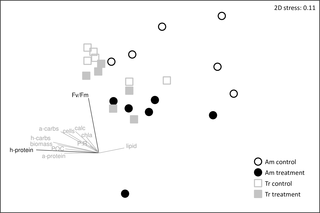PLOS ONE ( IF 2.9 ) Pub Date : 2018-01-16 , DOI: 10.1371/journal.pone.0191156 Andréa G. Grottoli , Paula Dalcin Martins , Michael J. Wilkins , Michael D. Johnston , Mark E. Warner , Wei-Jun Cai , Todd F. Melman , Kenneth D. Hoadley , D. Tye Pettay , Stephen Levas , Verena Schoepf

|
Rising seawater temperature and ocean acidification threaten the survival of coral reefs. The relationship between coral physiology and its microbiome may reveal why some corals are more resilient to these global change conditions. Here, we conducted the first experiment to simultaneously investigate changes in the coral microbiome and coral physiology in response to the dual stress of elevated seawater temperature and ocean acidification expected by the end of this century. Two species of corals, Acropora millepora containing the thermally sensitive endosymbiont C21a and Turbinaria reniformis containing the thermally tolerant endosymbiont Symbiodinium trenchi, were exposed to control (26.5°C and pCO2 of 364 μatm) and treatment (29.0°C and pCO2 of 750 μatm) conditions for 24 days, after which we measured the microbial community composition. These microbial findings were interpreted within the context of previously published physiological measurements from the exact same corals in this study (calcification, organic carbon flux, ratio of photosynthesis to respiration, photosystem II maximal efficiency, total lipids, soluble animal protein, soluble animal carbohydrates, soluble algal protein, soluble algal carbohydrate, biomass, endosymbiotic algal density, and chlorophyll a). Overall, dually stressed A. millepora had reduced microbial diversity, experienced large changes in microbial community composition, and experienced dramatic physiological declines in calcification, photosystem II maximal efficiency, and algal carbohydrates. In contrast, the dually stressed coral T. reniformis experienced a stable and more diverse microbiome community with minimal physiological decline, coupled with very high total energy reserves and particulate organic carbon release rates. Thus, the microbiome changed and microbial diversity decreased in the physiologically sensitive coral with the thermally sensitive endosymbiotic algae but not in the physiologically tolerant coral with the thermally tolerant endosymbiont. Our results confirm recent findings that temperature-stress tolerant corals have a more stable microbiome, and demonstrate for the first time that this is also the case under the dual stresses of ocean warming and acidification. We propose that coral with a stable microbiome are also more physiologically resilient and thus more likely to persist in the future, and shape the coral species diversity of future reef ecosystems.
中文翻译:

变暖和海洋酸化共同作用下的珊瑚生理学和微生物组动力学
海水温度上升和海洋酸化威胁着珊瑚礁的生存。珊瑚生理与其微生物组之间的关系可能揭示了为什么某些珊瑚对这些全球变化条件具有更强的抵抗力。在这里,我们进行了第一个实验,以同时调查珊瑚微生物组和珊瑚生理变化,以应对本世纪末预期的海水温度升高和海洋酸化带来的双重压力。两个物种珊瑚,鹿角millepora含有热敏感共生细菌C21A和Turbinaria腔肠含有热耐受共生细菌共生trenchi,暴露于对照(26.5℃,p CO 2364μatm)和处理(29.0°C和750μatm的p CO 2)条件持续24天,之后我们测量了微生物群落组成。这些微生物的发现是在先前发表的这项研究中完全相同的珊瑚的生理测量结果中得到解释的(钙化,有机碳通量,光合作用与呼吸的比率,光系统II的最大效率,总脂质,可溶性动物蛋白,可溶性动物碳水化合物,可溶性藻蛋白,可溶性藻糖,生物量,内共生藻密度和叶绿素a)。总体而言,双重强调一个。千足虫降低了微生物多样性,使微生物群落组成发生了巨大变化,并且钙化,光系统II的最大效率和藻类碳水化合物发生了显着的生理下降。相比之下,双重强调珊瑚牛逼。肾形目经历了一个稳定而多样化的微生物组群落,其生理衰退最小,再加上非常高的总能量储备和颗粒状有机碳释放速率。因此,在具有热敏感性内共生藻类的生理敏感珊瑚中,微生物组发生变化,并且微生物多样性降低,但是在具有耐热性内共生菌的生理耐受性珊瑚中,微生物组没有变化,而微生物多样性降低。我们的结果证实了最近的发现,即耐温应力的珊瑚具有更稳定的微生物组,并首次证明在海洋变暖和酸化的双重压力下也是如此。我们建议,具有稳定微生物组的珊瑚还具有更好的生理弹性,因此在未来更可能持久存在,并塑造了未来礁石生态系统的珊瑚物种多样性。











































 京公网安备 11010802027423号
京公网安备 11010802027423号